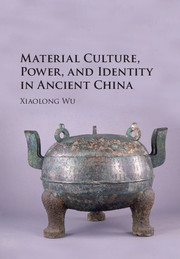Book contents
- Frontmatter
- Dedication
- Contents
- List of Figures
- List of Maps
- List of Tables
- Acknowledgments
- INTRODUCTION
- 1 HISTORICAL SETTING AND APPROACHES TO THE STUDY OF AN ANCIENT STATE IN WARRING STATES CHINA
- 2 LIFE, DEATH, AND IDENTITY IN ZHONGSHAN: SORTING OUT THE ARCHAEOLOGICAL EVIDENCE
- 3 ROYAL MORTUARY PRACTICE AND ARTIFACTS: HYBRIDITY, IDENTITY, AND POWER
- 4 INTERSTATE POLITICS AND ARTISTIC INNOVATION DURING THE REIGN OF KING CUO
- 5 STATECRAFT AND ZHONGSHAN BRONZE INSCRIPTIONS
- 6 FUNERARY ARCHITECTURE, KINGLY POWER, AND COURT POLITICS
- CONCLUSION
- Appendices
- Notes
- Bibliography
- Index
5 - STATECRAFT AND ZHONGSHAN BRONZE INSCRIPTIONS
Published online by Cambridge University Press: 23 March 2017
- Frontmatter
- Dedication
- Contents
- List of Figures
- List of Maps
- List of Tables
- Acknowledgments
- INTRODUCTION
- 1 HISTORICAL SETTING AND APPROACHES TO THE STUDY OF AN ANCIENT STATE IN WARRING STATES CHINA
- 2 LIFE, DEATH, AND IDENTITY IN ZHONGSHAN: SORTING OUT THE ARCHAEOLOGICAL EVIDENCE
- 3 ROYAL MORTUARY PRACTICE AND ARTIFACTS: HYBRIDITY, IDENTITY, AND POWER
- 4 INTERSTATE POLITICS AND ARTISTIC INNOVATION DURING THE REIGN OF KING CUO
- 5 STATECRAFT AND ZHONGSHAN BRONZE INSCRIPTIONS
- 6 FUNERARY ARCHITECTURE, KINGLY POWER, AND COURT POLITICS
- CONCLUSION
- Appendices
- Notes
- Bibliography
- Index
Summary
THE BRONZE INDUSTRY PLAYED AN ESSENTIAL ROLE IN STATE POLITICS during the Shang and Zhou dynasties. The words uttered by Liu Kang Gong in the Zuozhuan in 578 BCE summarized the two important components of statecraft during his time: “the important affairs of the state are ritual sacrifices and warfare.” Bronze ritual vessels and weapons were undoubtedly both the symbols and important devices for the operation of the state machinery. During the Warring States Period, the economic infrastructure and sociopolitical organization in all the contending states experienced dramatic changes, and different philosophies of statecraft flourished. During the Spring and Autumn Period (770–477 BCE), each Zhou state was ruled in a familial manner by several noble families. A new form of state, in which “the ruler wielded despotic power and ministers could be brought into and discharged from a bureaucratic system that selected and promoted competent men and rejected the unqualified,” appeared during the second half of the fifth century BCE. What role did the bronze industry play in helping to shape the new form of statecraft during this period? And how did the new role that bronzes were expected to play transform their function and style? This chapter discusses these questions through the analysis of Zhongshan bronzes in relation to the sociopolitical circumstances under which they were produced.
These questions can be discussed by combining different sources and methods, including analysis of style, inscriptions, and historical texts. Three bronze vessels from Cuo's tomb have long inscriptions engraved on their outer surface, and a unique bronze panel from his tomb bears an edict of King Cuo and a blueprint of his tomb complex. These inscriptions and historical texts shed light on each other, and, in combination with the analysis of the artifacts, suggest that the Zhongshan bronzes were closely related to politics and statecraft. The political concerns of the patrons affected the production of those bronze artifacts and the inscriptions changed the role of the bronzes themselves.
THE POLITICAL OVERTONES OF THE COMMEMORATIVE INSCRIPTIONS: CREATING NEW MEANING WITH AN OLD TRADITION
The three bronze ritual vessels excavated from King Cuo's tomb that bear long incised inscriptions are a ding (XK: 1) with three iron legs and a square hu (XK: 15) in the west storage chamber, and a round hu (DK: 6) in the east storage chamber, all commissioned by Cuo and cast in the state foundry.
- Type
- Chapter
- Information
- Material Culture, Power, and Identity in Ancient China , pp. 149 - 170Publisher: Cambridge University PressPrint publication year: 2017



